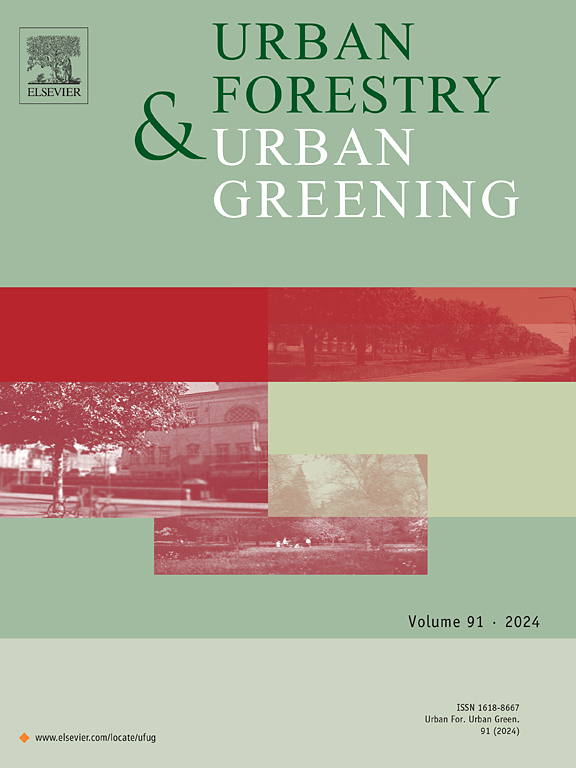Adaptive shading: How microclimates and surface types amplify tree cooling effects?
IF 6
2区 环境科学与生态学
Q1 ENVIRONMENTAL STUDIES
引用次数: 0
Abstract
Shading is the most critical process in tree cooling. Although the influence of tree features on shade supply has been extensively studied, the efficiency of shade performance in diverse environments remains poorly understood. The latter is crucial, as urban areas are highly heterogeneous, and local microclimates and land cover heterogeneity are among the most perceptible and observable aspects. We randomly selected several typical tree patches in Beijing to explore whether and how tree-shade efficiency varies with these factors. We used temporal variations as a proxy to study the impact of microclimatic heterogeneity on tree shade efficiency by comparing sunny and cloudy conditions, as well as different times of the day. In addition, we investigated the differences in shading efficiency over various surfaces by comparing pairs of regular urban surfaces (asphalt, concrete, permeable brick, and grass). We found that tree shade significantly improved the local thermal environment, but its effectiveness varied with the environmental conditions. Tree shading resulted in a higher cooling efficiency under greater external thermal stress. In addition, the cooling efficiency was greater on surfaces with higher temperatures. We also identified a notable characteristic of tree shading for cooling: the thermal environment beneath the tree shade tends to stabilize at a relatively constant value across various external conditions. These results provide practical guidelines for optimizing tree layouts in highly heterogeneous urban environments and enhancing limited tree resources for more effective and economical improvement of urban thermal conditions.
适应性遮阳:小气候和地表类型如何放大树木的冷却效应?
遮荫是树木降温的最关键过程。虽然人们已经广泛研究了树木特征对遮阳的影响,但对不同环境中遮阳的效率仍然知之甚少。后者至关重要,因为城市地区具有高度异质性,而局部微气候和土地覆盖异质性是最易感知和观察到的方面。我们在北京随机选取了几个典型的树木斑块,以探讨树木遮荫效率是否以及如何随这些因素而变化。我们以时间变化为代表,通过比较晴天和阴天以及一天中的不同时间,研究小气候异质性对树木遮荫效率的影响。此外,我们还通过比较成对的常规城市地面(沥青、混凝土、透水砖和草地),研究了各种地面遮阳效率的差异。我们发现,树荫能明显改善当地的热环境,但其效果因环境条件而异。在外部热应力较大的情况下,树荫能带来更高的冷却效率。此外,在温度较高的地面上,降温效率更高。我们还发现了树荫降温的一个显著特点:在各种外部条件下,树荫下的热环境趋于稳定在一个相对恒定的值。这些结果为在高度异质的城市环境中优化树木布局提供了实用的指导,并能提高有限的树木资源,从而更有效、更经济地改善城市热环境。
本文章由计算机程序翻译,如有差异,请以英文原文为准。
求助全文
约1分钟内获得全文
求助全文
来源期刊

Urban Forestry & Urban Greening
FORESTRY-
CiteScore
11.70
自引率
12.50%
发文量
289
审稿时长
70 days
期刊介绍:
Urban Forestry and Urban Greening is a refereed, international journal aimed at presenting high-quality research with urban and peri-urban woody and non-woody vegetation and its use, planning, design, establishment and management as its main topics. Urban Forestry and Urban Greening concentrates on all tree-dominated (as joint together in the urban forest) as well as other green resources in and around urban areas, such as woodlands, public and private urban parks and gardens, urban nature areas, street tree and square plantations, botanical gardens and cemeteries.
The journal welcomes basic and applied research papers, as well as review papers and short communications. Contributions should focus on one or more of the following aspects:
-Form and functions of urban forests and other vegetation, including aspects of urban ecology.
-Policy-making, planning and design related to urban forests and other vegetation.
-Selection and establishment of tree resources and other vegetation for urban environments.
-Management of urban forests and other vegetation.
Original contributions of a high academic standard are invited from a wide range of disciplines and fields, including forestry, biology, horticulture, arboriculture, landscape ecology, pathology, soil science, hydrology, landscape architecture, landscape planning, urban planning and design, economics, sociology, environmental psychology, public health, and education.
 求助内容:
求助内容: 应助结果提醒方式:
应助结果提醒方式:


